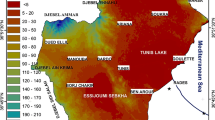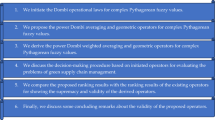Abstract
There is an increase in the number of people who have changed their country for compulsory reasons due to the wars experienced worldwide. This raises the problem of identifying the regions where these people, called refugees, will live in the countries. In this regard, we determine in this paper where the camps established for refugees living in Istanbul should be located. The presence of many quantitative and qualitative factors which should be handled in determining the best location has enabled this problem to have multi-criteria decision-making structure. In addition, the advantage of fuzzy logic is used to convert the evaluations taken from experts into available numbers and to include them in decision-making process. For this purpose, a novel model with the integration of Pythagorean fuzzy AHP and Pythagorean fuzzy WASPAS methods is proposed for the first time in the literature, to select the best location for the refugee camp. In addition, a comparative analysis is applied to determine the validity of the results obtained and the sensitivity analysis is applied to check the robustness of the model. As a result, the most suitable location for a refugee camp in Istanbul is identified reasonably with the proposed model.






Similar content being viewed by others
References
UNHCR (2019) Refugees
UNHCR (2019) Asylum-seekers
UNHCR Figures at a Glance. https://www.unhcr.org/figures-at-a-glance.html. Accessed 12 Apr 2020
Yildiz A, Ayyildiz E, Gumus AT, Ozkan C (2020) A modified balanced scorecard based hybrid pythagorean fuzzy AHP-topsis methodology for ATM site selection problem. Int J Inf Technol Decis Mak 19:365–384. https://doi.org/10.1142/S0219622020500017
Avazbeigi M (2009) An overview of complexity theory. In: contributions to management science. Springer, pp 19–36
Erdoʇan M, Kaya I (2016) A combined fuzzy approach to determine the best region for a nuclear power plant in Turkey. Appl Soft Comput J 39:84–93. https://doi.org/10.1016/j.asoc.2015.11.013
Zadeh LA (1965) Fuzzy sets. Ing Control 8:338–353. https://doi.org/10.1016/S0019-9958(65)90241-X
Ayyildiz E, Taskin Gumus A, Erkan M (2020) Individual credit ranking by an integrated interval type-2 trapezoidal fuzzy Electre methodology. Soft Comput 24:16149–16163. https://doi.org/10.1007/s00500-020-04929-1
Wang JQ, Peng JJ, Zhang HY et al (2015) An uncertain linguistic multi-criteria group decision-making method based on a cloud model. Gr Decis Negot 24:171–192. https://doi.org/10.1007/s10726-014-9385-7
Zadeh LA (1975) The concept of a linguistic variable and its application to approximate reasoning-II. Inf Sci (Ny) 8:301–357. https://doi.org/10.1016/0020-0255(75)90046-8
Atanassov KT (1999) Intuitionistic fuzzy sets. Physica, Heidelberg, pp 1–137
Yager RR (2013) Pythagorean fuzzy subsets. In: Proceedings of the 2013 joint IFSA world congress and NAFIPS annual meeting, IFSA/NAFIPS 2013. pp 57–61
Zeng S, Chen J, Li X (2016) A hybrid method for pythagorean fuzzy multiple-criteria decision making. https://doi.org/10.1142/S0219622016500012
Gul M (2018) Application of Pythagorean fuzzy AHP and VIKOR methods in occupational health and safety risk assessment: the case of a gun and rifle barrel external surface oxidation and colouring unit. Int J Occup Saf Ergon. https://doi.org/10.1080/10803548.2018.1492251
Garg H (2016) A novel correlation coefficients between pythagorean fuzzy sets and its applications to decision-making processes. Int J Intell Syst 31:1234–1252. https://doi.org/10.1002/int.21827
Zhu J, Li Y (2018) Pythagorean fuzzy Muirhead mean operators and their application in multiple-criteria group decision-making. Information 9:142. https://doi.org/10.3390/info9060142
Yucesan M, Gul M (2020) Hospital service quality evaluation: an integrated model based on pythagorean fuzzy AHP and fuzzy TOPSIS. Soft Comput 24:3237–3255. https://doi.org/10.1007/s00500-019-04084-2
Garfì M, Tondelli S, Bonoli A (2009) Multi-criteria decision analysis for waste management in Saharawi refugee camps. Waste Manag 29:2729–2739. https://doi.org/10.1016/j.wasman.2009.05.019
Çetinkaya C, Özceylan E, Erbaş M, Kabak M (2016) GIS-based fuzzy MCDA approach for siting refugee camp: a case study for southeastern Turkey. Int J Disaster Risk Reduct 18:218–231. https://doi.org/10.1016/j.ijdrr.2016.07.004
Omidvar B, Baradaran-Shoraka M, Nojavan M (2013) Temporary site selection and decision-making methods: a case study of Tehran. Iran Disasters 37:536–553. https://doi.org/10.1111/disa.12007
Hadavi F, Zamani M, Movasati M, et al (2014) Optimal site selection for temporary housing after an earthquake in urban areas using multiple criteria decision making methods and GIS (a case study of municipal district 6, Tehran metropolis). J Bio Env Sci 2014:6–13
Hosseini SMA, de la Fuente A, Pons O (2016) Multicriteria decision-making method for sustainable site location of post-disaster temporary housing in urban areas. J Constr Eng Manag 142:04016036. https://doi.org/10.1061/(ASCE)CO.1943-7862.0001137
Karasan A, Ilbahar E, Kahraman C (2019) A novel pythagorean fuzzy AHP and its application to landfill site selection problem. Soft Comput 23:10953–10968. https://doi.org/10.1007/s00500-018-3649-0
Ayyildiz E, Taskin Gumus A (2020) A novel spherical fuzzy AHP-integrated spherical WASPAS methodology for petrol station location selection problem: a real case study for İstanbul. Environ Sci Pollut Res 27:36109–36120. https://doi.org/10.1007/s11356-020-09640-0
Otay I, Atik S (2021) Multi-criteria oil station location evaluation using spherical AHP and WASPAS: a real-life case study. In: Advances in intelligent systems and computing. Springer, pp 591–598
Baušys R, Juodagalvienė B, Žiūrienė R et al (2020) The residence plot selection model for family house in Vilnius by neutrosophic WASPAS method. Int J Strateg Prop Manag 24:182–196. https://doi.org/10.3846/ijspm.2020.12107
Turskis Z, Zavadskas EK, Antucheviciene J, Kosareva N (2015) A hybrid model based on fuzzy AHP and fuzzy WASPAS for construction site selection. Int J Comput Commun Control 10:873–888. https://doi.org/10.15837/ijccc.2015.6.2078
Karasan A, Ilbahar E, Cebi S, Kahraman C (2018) A new risk assessment approach: safety and critical effect analysis (SCEA) and its extension with pythagorean fuzzy sets. Saf Sci 108:173–187. https://doi.org/10.1016/j.ssci.2018.04.031
Ilbahar E, Karaşan A, Cebi S, Kahraman C (2018) A novel approach to risk assessment for occupational health and safety using Pythagorean fuzzy AHP and fuzzy inference system. Saf Sci 103:124–136. https://doi.org/10.1016/j.ssci.2017.10.025
Garg H (2017) A new improved score function of an interval-valued pythagorean fuzzy set based topsis method. Int J Uncertain Quantif 7:463–474. https://doi.org/10.1615/Int.J.UncertaintyQuantification.2017020197
Garg H (2016) A novel accuracy function under interval-valued pythagorean fuzzy environment for solving multicriteria decision making problem J. Intell Fuzzy Syst 31:529–540. https://doi.org/10.3233/IFS-162165
Peng X, Yang Y (2016) Fundamental properties of interval-valued pythagorean fuzzy aggregation operators. Int J Intell Syst 31:444–487. https://doi.org/10.1002/int.21790
Özkan B, Kaya İ, Erdoğan M, Karaşan A (2020) Evaluating blockchain risks by using a MCDM methodology based on pythagorean fuzzy sets. Springer
Gul M, Ak MF (2018) A comparative outline for quantifying risk ratings in occupational health and safety risk assessment. J Clean Prod 196:653–664. https://doi.org/10.1016/j.jclepro.2018.06.106
Karasan A, Kaya İ, Erdoğan M, Budak A (2020) Risk analysis of the autonomous vehicle driving systems by using pythagorean fuzzy AHP. In: Advances in intelligent systems and computing. Springer, pp 926–934
Zavadskas EK, Turskis Z, Antucheviciene J, Zakarevicius A (2012) Optimization of weighted aggregated sum product assessment. Elektron ir Elektrotechnika 122:3–6. https://doi.org/10.5755/j01.eee.122.6.1810
Zavadskas EK, Bausys R, Mazonaviciute I (2019) Safety evaluation methodology of urban public parks by multi-criteria decision making. Landsc Urban Plan 189:372–381. https://doi.org/10.1016/j.landurbplan.2019.05.014
Urosevic S, Karabasevic D, Stanujkic D, Maksimovic M (2017) An approach to personnel selection in the tourism industry based on the SWARA and the WASPAS methods. Econ Comput Econ Cybern Stud Res 51
Lescauskiene I, Bausys R, Zavadskas EK, Juodagalviene B (2020) VASMA weighting: survey-based criteria weighting methodology that combines ENTROPY and WASPAS-SVNS to reflect the psychometric features of the VAS scales. Symmetry (Basel) 12:1641. https://doi.org/10.3390/sym12101641
Kir S, Yazgan HR (2018) Hesitant fuzzy axiomatic design technique: a case for humanitarian relief. In: Journal of intelligent and fuzzy systems. IOS Press, pp 4181–4189
Nappi MML, Souza JC (2014) Disaster management: hierarchical structuring criteria for selection and location of temporary shelters. Nat Hazards 75:2421–2436. https://doi.org/10.1007/s11069-014-1437-4
Roh SY, Jang HM, Han CH (2013) Warehouse location decision factors in humanitarian relief logistics. Asian J Shipp Logist 29:103–120. https://doi.org/10.1016/j.ajsl.2013.05.006
Kilci F, Kara BY, Bozkaya B (2015) Locating temporary shelter areas after an earthquake: a case for Turkey. Eur J Oper Res 243:323–332. https://doi.org/10.1016/j.ejor.2014.11.035
Roh S, Pettit S, Harris I, Beresford A (2015) The pre-positioning of warehouses at regional and local levels for a humanitarian relief organisation. Int J Prod Econ 170:616–628. https://doi.org/10.1016/j.ijpe.2015.01.015
Nakamura Y (2005) Public health impact of disaster on children. Japan Med Assoc J 48:377–386
İçişleri TC Bakanlığı Göç İdaresi Genel Müdürlüğü
Erdoğan M (2017) “KOPUŞ”TAN “UYUM”A KENT MÜLTECİLERİ, Suriyeli Mülteciler ve Belediyelerin Süreç Yönetimi: İstanbul Örneği
Kutlu Gundogdu F, Kahraman C (2019) Extension of WASPAS with spherical fuzzy sets. Inform 30:269–292. https://doi.org/10.15388/Informatica.2019.206
Wang YJ (2015) A fuzzy multi-criteria decision-making model based on simple additive weighting method and relative preference relation. Appl Soft Comput J 30:412–420. https://doi.org/10.1016/j.asoc.2015.02.002
Zandi F (2014) A bi-level interactive decision support framework to identify data mining-oriented electronic health record architectures. Appl Soft Comput J 18:136–145. https://doi.org/10.1016/j.asoc.2014.01.001
Goyal RK, Kaushal S, Sangaiah AK (2018) The utility based non-linear fuzzy AHP optimization model for network selection in heterogeneous wireless networks. Appl Soft Comput J 67:800–811. https://doi.org/10.1016/j.asoc.2017.05.026
Sadeghi J, Niaki STA (2015) Two parameter tuned multi-objective evolutionary algorithms for a bi-objective vendor managed inventory model with trapezoidal fuzzy demand. Appl Soft Comput J 30:567–576. https://doi.org/10.1016/j.asoc.2015.02.013
Zare Mehrjerdi Y (2014) Strategic system selection with linguistic preferences and grey information using MCDM. Appl Soft Comput J 18:323–337. https://doi.org/10.1016/j.asoc.2013.09.013
Kahraman C, Öztayşi B, Çevik Onar S (2020) An integrated intuitionistic fuzzy AHP and TOPSIS approach to evaluation of outsource manufacturers. J Intell Syst 29:283–297. https://doi.org/10.1515/jisys-2017-0363
Funding
No funds, grants or other support was received.
Author information
Authors and Affiliations
Contributions
EA and ME developed the theoretical formulation, performed the analytic calculations and performed the numerical analysis. EA and ATG contributed to the sensitivity analysis and final version of the manuscript. EA and ME drafted the manuscript. ATG supervised the work.
Corresponding author
Ethics declarations
Conflict of interest
All authors certify that they have no affiliations with or involvement in any organization or entity with any financial interest or non-financial interest in the subject matter or materials discussed in this manuscript.
Ethical approval
Ethics committee approval is not required.
Consent to publish
The authors confirm that the final version of the manuscript has been reviewed, approved and consented for publication by all authors.
Additional information
Publisher's Note
Springer Nature remains neutral with regard to jurisdictional claims in published maps and institutional affiliations.
Rights and permissions
About this article
Cite this article
Ayyildiz, E., Erdogan, M. & Taskin Gumus, A. A Pythagorean fuzzy number-based integration of AHP and WASPAS methods for refugee camp location selection problem: a real case study for Istanbul, Turkey. Neural Comput & Applic 33, 15751–15768 (2021). https://doi.org/10.1007/s00521-021-06195-0
Received:
Accepted:
Published:
Issue Date:
DOI: https://doi.org/10.1007/s00521-021-06195-0




